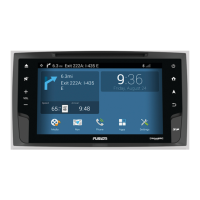Saving a Preset
1
While using the Radio or SiriusXM source, tune the station
or channel you want to save.
2
Select an option to choose a preset group:
• To choose an AM or FM radio preset group, select AM or
FM repeatedly.
• To choose a SiriusXM preset group, select the preset
group name.
TIP: The preset group name appears at the top of the tuner
page. For example, FM1 or SXM-1.
3
Select .
4
Select a preset number.
Removing a Preset
1
While using the Radio or SiriusXM source, select the preset
number you want to remove.
2
Select .
External Sources
You can view or listen to media from an external media player
by connecting it to an auxiliary input. While using an external
media source, you must control playback using the media player
instead of the stereo.
Connecting and Listening to an Auxiliary Audio
Source
1
Select an option:
• Locate the auxiliary input in your vehicle.
This may be located on the dash or in the console, and
may be either a 3.5 mm line-in audio jack or a pair of
stereo RCA inputs.
• Locate the auxiliary connectors on the stereo wiring
harness.
For more information, see the FUSION RV-IN801
Infotainment SystemInstallation Instructions.
2
Connect your media device to the auxiliary input.
3
Select Media > Audio > AUX In.
4
Control playback using your auxiliary media device.
Connecting and Viewing an hdmi Source
NOTE: The stereo may not be compatible with all hdmi sources.
1
Open the hdmi port cover on the front of the stereo.
2
Connect your media device to the hdmi port.
3
Select Apps > HDMI.
4
Control playback using your hdmi device.
Wi‑Fi CERTIFIED MiraCast
™
Wi‑Fi CERTIFIED MiraCast technology allows you to transmit
video wirelessly to your stereo from a compatible smartphone or
media device. This feature is also known as "casting" on some
devices.
Transmitting Video to the Stereo Wirelessly
1
On the stereo, select Apps > Miracast.
2
Select the toggle switch to turn on Wi‑Fi CERTIFIED
MiraCast technology.
3
From your smartphone or media device, enable the wireless
display feature, and select the stereo from the device list.
This feature may be found in the display settings and may be
called "cast," "wireless display," or another name. For more
information, see the owner's manual for your smartphone or
media device.
Navigation
Vehicle Profiles
A vehicle profile stores characteristics of your vehicle, such as
the height, width, and weight. Routing and navigation are
calculated differently based on your vehicle profile.
In most cases, you should use the default manufacturer vehicle
profile. This profile has already been configured by the
manufacturer for your vehicle specifications. You can add a
custom vehicle profile for alternative vehicle configurations, such
as when you are pulling a trailer, or if you add an accessory that
changes the overall dimensions of your vehicle.
Adding a Vehicle Profile
1
Select Settings > Navigation > Vehicle Profile.
2
Select .
3
Select an option to enable or disable audible alerts while
using this profile.
Audible alerts can help to inform you of changes in the
driving conditions, such as an upcoming speed limit change
or height restriction.
4
Follow the on-screen instructions to enter your vehicle
information.
5
Select Save.
Activating a Vehicle Profile
1
Select Settings > Navigation > Vehicle Profile.
2
Select a vehicle profile.
The vehicle profile information appears, including
measurements and weight.
3
Select Select Profile.
Editing a Vehicle Profile
You can change basic vehicle profile information or add detailed
information to a vehicle profile, such as maximum speed.
1
Select Settings > Navigation > Vehicle Profile.
2
Select the vehicle profile to edit.
3
Select > Edit.
4
Select an option:
• To edit the vehicle profile information, select a field to edit.
• To rename a vehicle profile, select > Rename Profile.
• To delete the vehicle profile, select > Delete.
5
Select Save.
Routes
A route is a path from your current location to one or more
destinations.
• The device calculates a recommended route to your
destination based on the preferences you set, including the
route calculation mode (Changing the Route Calculation
Mode, page 5) and avoidances (Avoiding Delays, Tolls,
and Areas, page 9).
• The device can automatically avoid roads that are not
appropriate for the active vehicle profile.
• You can start navigating to your destination quickly using the
recommended route, or you can select an alternate route
(Starting a Route, page 6).
• If there are specific roads you need to use or avoid, you can
customize the route.
• You can add multiple destinations to a route (Adding a
Location to a Route, page 6).
Changing the Route Calculation Mode
1
Select Settings > Navigation > Calculation Mode.
Navigation 5

